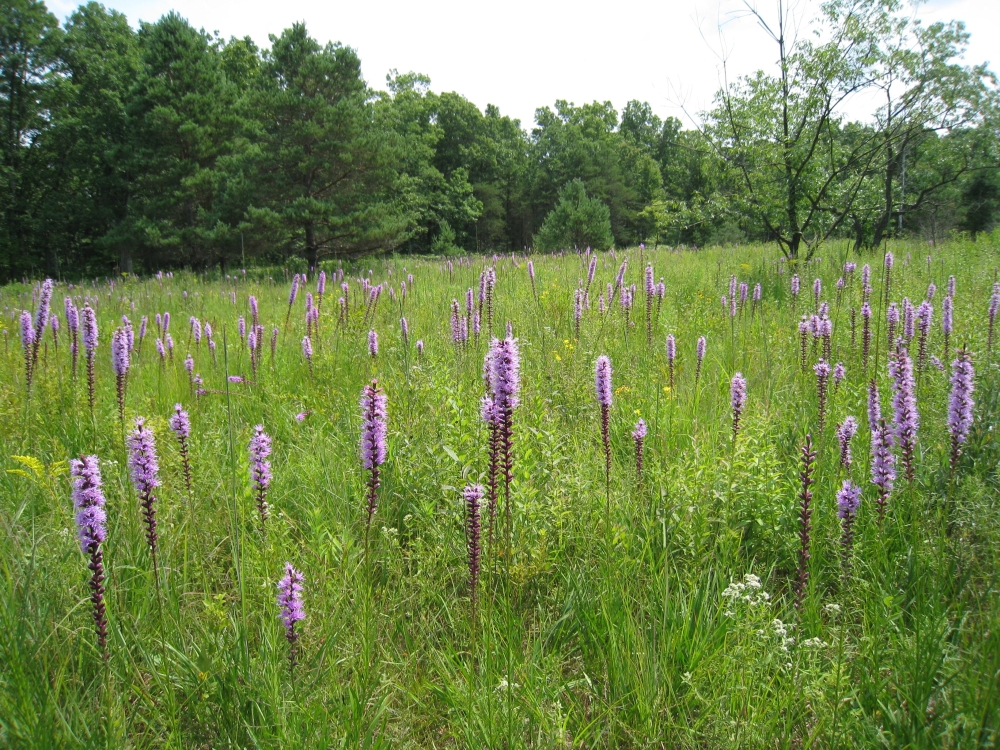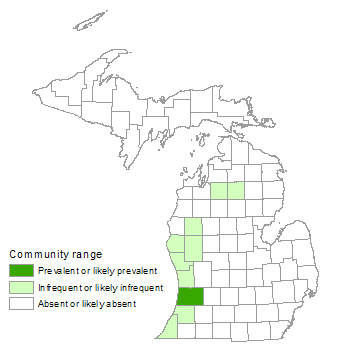Wet-mesic Sand Prairie
Overview
Wet-mesic sand prairie is a native lowland grassland occurring on sandy outwash plains and lakeplains within shallow depressions and as a vegetation zone separating fire-dependent upland and open wetland systems. The community occurs in the southern and northern Lower Peninsula on loamy sand or fine sand, usually with high organic content, and sometimes covered by a thin layer of muck. Sites that support wet-mesic sand prairie experience fluctuating water tables, with high water tables occurring in the spring followed by drought conditions in late summer and fall. Thus, the community contains species from a broad range of moisture classes, but is dominated by species of wetland affinity. Species dominance is shared by several prairie and wetland grasses and sedges. Historically, fire and beaver flooding played integral roles in maintaining the species composition and community structure of wet-mesic sand prairies.
Rank
Global Rank: G2G3 - Rank is uncertain, ranging from imperiled to vulnerable
State Rank: S2 - Imperiled

Landscape Context
Wet-mesic sand prairie occurs on sandy sites with high water tables such as those occurring in shallow depressions within sandy outwash plains, lakeplains, old abandoned glacial lakebeds, stream channels, and river terraces. It often occurs as a vegetation zone between fire-dependent uplands and open wetlands such as dry or dry-mesic forests and coastal plain marsh or intermittent wetland. Wet-mesic sand prairie generally occurs as small isolated patches within a broader matrix of fire-dependent communities such as pine barrens, oak-pine barrens, oak barrens, and associated dry and dry-mesic forests and open wetland types including coastal plain marsh, intermittent wetland, and bog.
Soils
Soils are loamy sand, loamy fine sand, or fine sand and are typically strongly acid to neutral. Soils often have high organic content, which increases water-holding capacity, and may be covered by a thin layer of muck. A high water table contributes to the wet-mesic condition of the sandy soils.
Natural Processes
Water level fluctuations and fire help maintain diversity and open conditions. Wet-mesic sand prairie experiences seasonal water table fluctuations, with the wettest conditions occurring in spring and driest periods in late summer and fall. Prolonged winter and spring inundation may occur in the wettest portions of some wet-mesic sand prairies. Seasonal and annual water level fluctuations create conditions suitable for plant species representing a broad range of moisture tolerances. In addition, a seasonally high water table and periods of saturation or inundation limit encroachment by shrubs and trees. Beaver can reduce shrub and tree cover by causing flooding, raising local water tables, and through herbivory. Prior to European settlement in the early 1800s, fires of natural and anthropogenic origin likely carried into the community from surrounding uplands and further limited encroachment by shrubs and trees. Fire helps maintain species diversity by facilitating seed germination, opening microsites for seedling establishment and growth of small species, and releasing important plant nutrients that bolster plant growth, flowering, and seed set.
Vegetation
Species dominance varies among several prairie and wetland grasses and sedges, including bluejoint grass (Calamagrostis canadensis), cordgrass (Spartina pectinata), big bluestem (Andropogon gerardii), little bluestem (Schizachyrium scoparium), prairie dropseed (Sporobolus heterolepis, state special concern), Indian grass (Sorghastrum nutans), and tussock sedge (Carex stricta). Shrubs are important in some occurrences, represented by tag alder (Alnus incana), black chokeberry (Aronia prunifolia), leatherleaf (Chamaedaphne calyculata), gray dogwood (Cornus foemina), red-osier dogwood (C. sericea), Kalm’s St. John’s-wort (Hypericum kalmianum), shrubby cinquefoil (Dasiphora fruticosa), pasture rose (Rosa carolina), northern dewberry (Rubus flagellaris), swamp dewberry (R. hispidus), willows (Salix spp.), and meadowsweet (Spiraea alba). Trees are occasional or patchy, represented by species typical of the surrounding landscape. Characteristic herbs include ticklegrass (Agrostis scabra), harebell (Campanula rotundifolia), sedges (Carex buxbaumii, C. flava, C. leptalea, C. pellita, C. pensylvanica), swamp thistle (Cirsium muticum), bastard toadflax (Comandra umbellata), golden-seeded spike-rush (Eleocharis elliptica), grass-leaved goldenrod (Euthamia graminifolia), wild strawberry (Fragaria virginiana), fowl manna grass (Glyceria striata), blue flags (Iris virginica and I. versicolor), rushes (i.e., Juncus balticus, J. effusus, J. greenei, and J. vaseyi, state threatened), cardinal flower (Lobelia cardinalis), pale spiked lobelia (L. spicata), common water horehound (Lycopus americanus), wild bergamot (Monarda fistulosa), northern panic grass (Dichanthelium boreale), switch grass (Panicum virgatum), water smartweed (Persicaria amphibia), Virginia mountain mint (Pycnanthemum virginianum), wool-grass (Scirpus cyperinus), balsam ragwort (Packera paupercula), common blue-eyed-grass (Sisyrinchium albidum), late goldenrod (Solidago gigantea), rough goldenrod (S. rugosa), purple meadow rue (Thalictrum dasycarpum), marsh fern (Thelypteris palustris), marsh St. John’s-wort (Triadenum fraseri), and white camas (Anticlea elegans). Invasive Canada bluegrass (Poa compressa) and Kentucky bluegrass (P. pratensis) are common in some sites.
For information about plant species, visit the Michigan Flora website.
Plant Lists
Graminoids
- ticklegrasses (Agrostis hyemalis and A. scabra)
- big bluestem (Andropogon gerardii)
- blue-joint (Calamagrostis canadensis)
- sedges (Carex buxbaumii, C. flava, C. leptalea, C. pellita, C. pensylvanica, C. stricta, and others)
- panic grasses (Dichanthelium spp.)
- golden-seeded spike-rush (Eleocharis elliptica)
- fowl manna grass (Glyceria striata)
- blue flags (Iris versicolor and I. virginica)
- rushes (Juncus balticus, J. brachycarpus, J. effusus, J. greenei, J. scirpoides, J. vaseyi, and others)
- switch grass (Panicum virgatum)
- brownish beak-rush (Rhynchospora capitellata)
- little bluestem (Schizachyrium scoparium)
- wool-grass (Scirpus cyperinus)
- tall nut-rush (Scleria triglomerata)
- Indian grass (Sorghastrum nutans)
- cordgrass (Spartina pectinata)
- prairie dropseed (Sporobolus heterolepis)
Forbs
- colic root (Aletris farinosa)
- white camas (Anticlea elegans)
- tall green milkweed (Asclepias hirtella)
- harebell (Campanula rotundifolia)
- swamp thistle (Cirsium muticum)
- bastard-toadflax (Comandra umbellata)
- tall coreopsis (Coreopsis tripteris)
- slender goldentop (Euthamia caroliniana)
- grass-leaved goldenrod (Euthamia graminifolia)
- wild strawberry (Fragaria virginiana)
- marsh blazing-star (Liatris spicata)
- cardinal flower (Lobelia cardinalis)
- pale spiked lobelia (Lobelia spicata)
- common water horehound (Lycopus americanus)
- lance-leaved loosestrife (Lysimachia lanceolata)
- wild bergamot (Monarda fistulosa)
- small sundrops (Oenothera perennis)
- balsam ragwort (Packera paupercula)
- water smartweed (Persicaria amphibia)
- common mountain mint (Pycnanthemum virginianum)
- common skullcap (Scutellaria galericulata)
- common blue-eyed-grass (Sisyrinchium albidum)
- goldenrods (Solidago gigantea, S. ohioensis, S. riddellii, S. rugosa, and others)
- hyssop hedge nettle (Stachys hyssopifolia)
- bushy aster (Symphyotrichum dumosum)
- long-leaved aster (Symphyotrichum robynsianum)
- purple meadow-rue (Thalictrum dasycarpum)
- marsh St. John’s-wort (Triadenum fraseri)
- Culver’s root (Veronicastrum virginicum)
- lance-leaved violet (Viola lanceolata)
- arrow-leaved violet (Viola sagittata)
Ferns
- marsh fern (Thelypteris palustris)
Shrubs
- tag alder (Alnus incana)
- black chokeberry (Aronia prunifolia)
- leatherleaf (Chamaedaphne calyculata)
- dogwoods (Cornus spp.)
- shrubby cinquefoil (Dasiphora fruticosa)
- Kalm’s St. John’s-wort (Hypericum kalmianum)
- shrubby St. John’s-wort (Hypericum prolificum)
- pasture rose (Rosa carolina)
- dewberries (Rubus spp.)
- willows (Salix spp.)
- meadowsweet (Spiraea alba)
- steeplebush (Spiraea tomentosa)
Noteworthy Animals
Beaver can cause flooding that substantially alters wetland community structure, converting lowland shrub and forest systems to a broad range of wetland types depending on landscape position, soils, and depth and duration of flooding.
Rare Plants
- Asclepias hirtella (tall green milkweed, state threatened)
- Carex tincta (sedge, state special concern)
- Draba nemorosa (whitlow-grass, presumed extirpated from Michigan)
- Helianthus mollis (downy sunflower, state threatened)
- Lactuca floridana (woodland lettuce, state threatened)
- Oxalis violacea (violet wood-sorrel, state threatened)
- Scirpus clintonii (Clinton’s bulrush, state special concern)
- Scleria triglomerata (tall nut-rush, state special concern)
- Sisyrinchium strictum (blue-eyed-grass, state special concern)
- Sporobolus heterolepis (prairie dropseed, state special concern)
- Strophostyles helvula (trailing wild bean, state special concern)
- Viola novae-angliae (New England violet, state threatened)
Rare Animals
- Ammodramus henslowii (Henslow’s sparrow, state threatened)
- Ammodramus savannarum (grasshopper sparrow, state special concern)
- Asio flammeus (short-eared owl, state endangered)
- Atrytonopsis hianna (dusted skipper, state threatened)
- Chlosyne gorgone carlota (Gorgone checkerspot, state special concern)
- Chondestes grammacus (lark sparrow, state endangered)
- Clemmys guttata (spotted turtle, state threatened)
- Elaphe o. obsoleta (black rat snake, state special concern)
- Emydoidea blandingii (Blanding’s turtle, state special concern)
- Lanius ludovicianus migrans (migrant loggerhead shrike, state endangered)
- Microtus ochrogaster (prairie vole, state endangered)
- Phyciodes batesii (tawny crescent, state special concern)
- Pygarctia spraguei (Sprague’s pygarctia, state special concern)
- Schinia indiana (phlox moth, state endangered)
- Sistrurus c. catenatus (eastern massasauga, federal candidate species and state special concern)
- Speyeria idalia (regal fritillary, state endangered)
- Spiza americana (dickcissel, state special concern)
- Sturnella neglecta (western meadowlark, state special concern)
- Terrapene c. carolina (eastern box turtle, state special concern)
Biodiversity Management Considerations
Threats to wet-mesic sand prairie include hydrologic alteration, fire suppression, tree and shrub encroachment, and destruction of upland buffers. Fire suppression and hydrologic alteration promote shrub and tree invasion, significantly reducing graminoid and sedge cover. Prescribed fire can be applied to restrict encroaching trees and shrubs, reduce thatch build-up, and promote seed bank expression. Sites impacted by severe encroachment of tall shrubs and trees are likely to require an initial step of cutting and herbiciding woody stems to prevent resprouting and facilitate growth of the fine herbaceous fuels needed to carry a fire. Restoration of the upland natural communities bordering wet-mesic sand prairie occurrences will improve hydrology and help provide refugia for flood-intolerant species during periods of high water.
Monitoring and control efforts to detect and remove invasive species are critical to the long-term viability of wet-mesic sand prairie. Invasive species that threaten the diversity and community structure include glossy buckthorn (Frangula alnus), common buckthorn (Rhamnus cathartica), autumn olive (Elaeagnus umbellata), Eurasian honeysuckles (especially Lonicera morrowii, L. tatarica, and L. xbella), multiflora rose (Rosa multiflora), reed (Phragmites australis subsp. australis), reed canary grass (Phalaris arundinacea), narrow-leaved cat-tail (Typha angustifolia), hybrid cat-tail (Typha xglauca), and purple loosestrife (Lythrum salicaria).
Variation
Species composition varies regionally.
Similar Natural Communities
Mesic sand prairie, wet-mesic prairie, wet prairie, lakeplain wet-mesic prairie, and lakeplain wet prairie.
Places to Visit
- Lidkey Swamp Prairie, Manistee National Forest, Oceana Co.
- Muskegon Wet-mesic Sand Prairie, Muskegon State Game Area, Newaygo Co.
- Portage Creek Complex, Grayling State Forest Management Unit, and Traverse City State Forest Management Unit, Crawford Co. and Kalkaska Co.
- Tussing Prairie, Manistee National Forest, Lake Co.
Relevant Literature
- Chapman, K.A. 1984. An ecological investigation of native grassland in southern Lower Michigan. M.A. thesis, Western Michigan University, Kalamazoo, MI.
- Faber-Langendoen, D., and P.F. Maycock. 1992. A vegetation analysis of tallgrass prairie in southern Ontario. Pp. 17-32 in Proceedings of the Thirteenth North American Prairie Conference: Spirit of the land, our prairie legacy, ed. R.G. Wickett, P.D. Lewis, A. Woodliffe. Department of Parks and Recreation, Windsor, Ontario, Canada. 262 pp.
- Kost, M.A., and J.G. Cohen. 2005. A reassessment of high quality natural communities on Camp Grayling. Report for Michigan Department of Military and Veterans Affairs, Camp Grayling, MI. Michigan Natural Features Inventory, Lansing, MI. 124 pp.
- NatureServe. 2006. NatureServe Explorer: An online encyclopedia of life [Web application]. Version 6.1. NatureServe, Arlington, VA. Available http://www.natureserve.org/explorer. (Accessed: January 12, 2007.)
For a full list of references used to create this description, please refer to the natural community abstract for Wet-mesic Sand Prairie.
More Information
Citation
Cohen, J.G., M.A. Kost, B.S. Slaughter, D.A. Albert, J.M. Lincoln, A.P. Kortenhoven, C.M. Wilton, H.D. Enander, and K.M. Korroch. 2020. Michigan Natural Community Classification [web application]. Michigan Natural Features Inventory, Michigan State University Extension, Lansing, Michigan. Available https://mnfi.anr.msu.edu/communities/classification. (Accessed: April 24, 2024).
Kost, M.A., D.A. Albert, J.G. Cohen, B.S. Slaughter, R.K. Schillo, C.R. Weber, and K.A. Chapman. 2007. Natural Communities of Michigan: Classification and Description. Michigan Natural Features Inventory, Report No. 2007-21, Lansing, MI.


